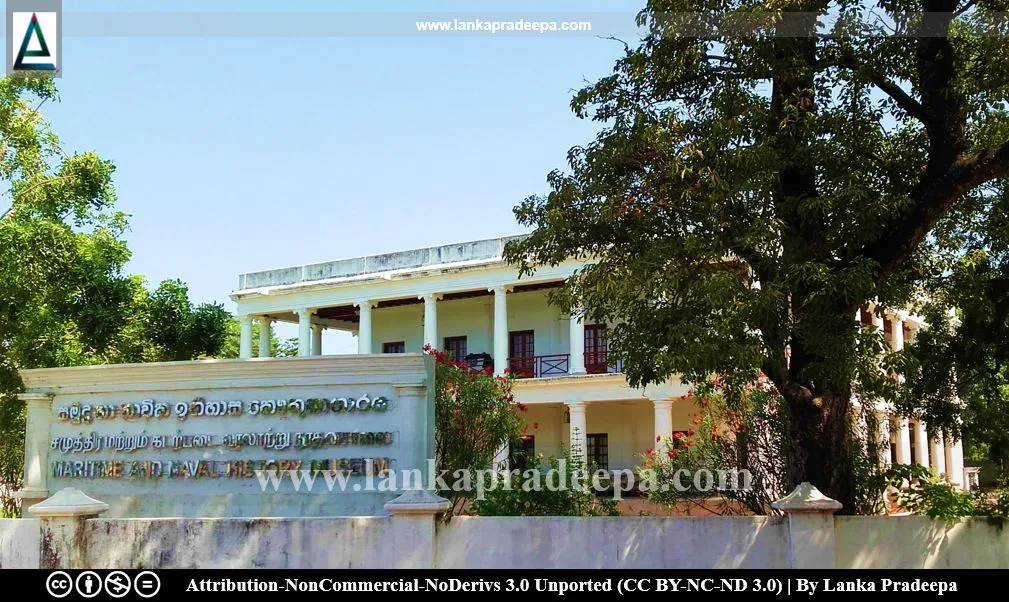
The Maritime and Naval History Museum (Sinhala: ත්රිකුණාමලය සමුද්ර හා නාවික ඉතිහාස කෞතුකාගාරය) is situated in Trincomalee town, Sri Lanka.
History
The museum has been established in a 17th-century A.D. old building used as the official residence of the Dutch Naval Commissioner in Trincomalee (Haramoto et al., 2015).
During the period between 1658-1796, most of the coastal areas in Sri Lanka were controlled by the Dutch. The Dutch constructed this two-story building following their traditional architectural practices, in Trincomalee during this period to be used as the official residence of the Naval Commissioner. After the British assumed control over the all-island (1796-1948 A.D.), they used this building as the official residence of a civil service official designated as a commissioner.
Subsequently, the building has been unused and the government of Sri Lanka renovated the building to be used as the Trincomalee British Center (the Kachcheri). However, the Kachcheri was brought to two buildings located inside Fort Fredrick, and as a result of that, this building once again became a deserted place. When Ranasinghe Premadasa became the Prime Minister of Sri Lanka (1977-1986), he tried to renovate this building but the efforts carried out during this period were not successful.
Later, this building and the land were handed over to Eastern University to be used as university property. The university used this building as a canteen and started to build a new lecture hall on the premises. However, the war between LTTE (a rebel group designated as a terrorist organization) and the government forces in the area resulted in the end of the university activities and therefore, this building and the land again became an uninhabited place. During this war season, the building was swallowed and ruined by the wild.
Once again, in 2007-2008, with financial assistance from the government of the Netherlands, the Sri Lanka Navy under the guidance of the Archaeological Department started the initial work for the preservation of the building to be used as a museum (Haramoto et al., 2015). The restoration works started in 2009 and were completed in February 2014 (Haramoto et al., 2015). The building was opened to the public as a museum on 3 February 2013, by the then Sri Lanka President Mahinda Rajapaksha and again in May 2014 by Speaker Chamal Rajapaksha.
During the period between 1658-1796, most of the coastal areas in Sri Lanka were controlled by the Dutch. The Dutch constructed this two-story building following their traditional architectural practices, in Trincomalee during this period to be used as the official residence of the Naval Commissioner. After the British assumed control over the all-island (1796-1948 A.D.), they used this building as the official residence of a civil service official designated as a commissioner.
Subsequently, the building has been unused and the government of Sri Lanka renovated the building to be used as the Trincomalee British Center (the Kachcheri). However, the Kachcheri was brought to two buildings located inside Fort Fredrick, and as a result of that, this building once again became a deserted place. When Ranasinghe Premadasa became the Prime Minister of Sri Lanka (1977-1986), he tried to renovate this building but the efforts carried out during this period were not successful.
Later, this building and the land were handed over to Eastern University to be used as university property. The university used this building as a canteen and started to build a new lecture hall on the premises. However, the war between LTTE (a rebel group designated as a terrorist organization) and the government forces in the area resulted in the end of the university activities and therefore, this building and the land again became an uninhabited place. During this war season, the building was swallowed and ruined by the wild.
Once again, in 2007-2008, with financial assistance from the government of the Netherlands, the Sri Lanka Navy under the guidance of the Archaeological Department started the initial work for the preservation of the building to be used as a museum (Haramoto et al., 2015). The restoration works started in 2009 and were completed in February 2014 (Haramoto et al., 2015). The building was opened to the public as a museum on 3 February 2013, by the then Sri Lanka President Mahinda Rajapaksha and again in May 2014 by Speaker Chamal Rajapaksha.
Museum
The museum preserves a collection of items that explain the country's maritime history, marine biodiversity and the history of local naval affairs. Exhibition rooms on the ground floor (approx. 766㎡) are themed on art and science, and feature the history of the navy, underwater heritages, and foreign trade while the first floor (approx. 707㎡) is themed on natural science and introduces marine life in relation to biodiversity (Haramoto et al., 2015).
The museum also displays panels of photographs of the building’s restoration process, the evolution of shipbuilding technologies, the advancement of maritime technologies and their wartime and commercial uses, and the marine environment of Sri Lanka (Haramoto et al., 2015).
References
1) Haramoto, T.; Inouchi, C.; Koizumi, Y.; Fukuyama, Y., 2015. Survey Report on the Protection and Utilisation of Cultural Property in the Northern and Northeastern Provinces of Sri Lanka. Japan Consortium for International Cooperation in Cultural Heritage. pp.23-25.Location Map
This page was last updated on 10 April 2023

